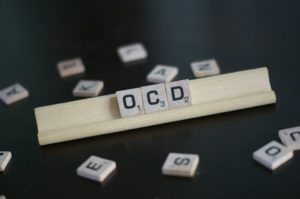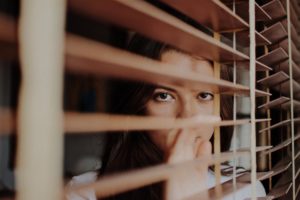Do you know someone who is always double checking to see if they locked the door? Or won’t eat if they don’t wash their hands at least three times? Maybe it’s your own behavior you’ve noticed, and you don’t know why you feel like you have to act that way.
 Something you may want to consider is a behavioral disorder known as OCD. This disorder is most often associated with repetitive or uncommon behavior. Many will see someone who stays very organized and say they are OCD as if OCD is a lifestyle decision rather than a disorder someone struggles with.
Something you may want to consider is a behavioral disorder known as OCD. This disorder is most often associated with repetitive or uncommon behavior. Many will see someone who stays very organized and say they are OCD as if OCD is a lifestyle decision rather than a disorder someone struggles with.
Rarely will you hear the actual name Obsessive Compulsive Disorder. I think people prefer to use the acronym because it isn’t culturally associated with a disorder. However, to say someone has an Obsessive Compulsive Disorder requires us to closely examine the symptoms before labeling them with a true case of OCD. Irvine Christian Counseling offers a compassionate approach to understanding and addressing OCD with proper assessment and care.
The symptoms of OCD often appear odd to others, but it’s important to keep in mind that not every odd tendency is a symptom of OCD. This article will attempt to explain some of the misunderstandings surrounding the symptoms of OCD. Hopefully, it will help bring clarity to those questioning if they, or someone they love, has OCD.
What is Obsessive Compulsive Disorder (OCD)?
What is Obsessive Compulsive Disorder? Is it just the tendency to be clean and tidy all of the time? Is it just the desire to reorganize any mess you encounter? Or the need to wash your hands ritualistically? These are a few of the behaviors commonly associated with OCD.
These actions can be a good starting point to ascertain if you yourself are dealing with OCD, but it isn’t a great idea to start diagnosing others based on such behavior. In reality, Obsessive Compulsive Disorder has several sets of technical criteria that need to be met before arriving a proper diagnosis. And it’s important to remember a diagnosis goes beyond just behavior, the patient’s thoughts must also be considered.
Obsessive Compulsive Disorder Symptoms
The symptoms required for a true diagnosis of Obsessive Compulsive Disorder are as follows:
Obsessions
An obsession is an undesired reoccurring thought, urge, or image, which appears during a stressful moment and/or an attempt to ignore those thoughts, urges, or images, by thinking of or doing something else (performing a compulsion).
Compulsions
 Compulsions are repetitive actions such as the ordering of objects, hand washing, double checking something, or other mental acts like counting, praying, or repeating words silently. When a person feels the need to perform one of the above actions in response to their obsession, then it is a compulsion. The behaviors are used to reduce distress or anxiety in stressful situations, even though the actions are not realistically connected to the events.
Compulsions are repetitive actions such as the ordering of objects, hand washing, double checking something, or other mental acts like counting, praying, or repeating words silently. When a person feels the need to perform one of the above actions in response to their obsession, then it is a compulsion. The behaviors are used to reduce distress or anxiety in stressful situations, even though the actions are not realistically connected to the events.
Obsessions and Compulsions
Obsessions and compulsions take up a lot of time, more than an hour each day, and interfere with social, occupational, and other areas of the patient’s life. These obsessions or compulsions cannot be explained by another mental disorder or medical condition.
Common Misunderstood Symptoms
It is important to remember that everyone is different. Some people may exhibit behavior that seems to be a clear indication of an Obsessive Compulsive Disorder, while others may not. The content of their obsessions and compulsions will vary from person to person, but some symptoms seem to transcend the disorder.
Some of the more common symptoms of an Obsessive Compulsive Disorder are things such as cleaning, symmetry (repeating, ordering, and counting), taboo or forbidden thoughts, and harm (feelings of fear regarding one’s own or another’s safety).
While it might seem someone fulfilling a compulsion is doing it for their own pleasure, they are really doing it to release the pressure of an obsessive thought. The obsessive urges, thoughts, or images do not bring pleasure, but rather are intrusive and undesired, usually causing distress.
Typically an Obsessive Compulsive Disorder comes with both obsessions and compulsions. The obsessive thoughts trigger the compulsive behavior in an attempt to prevent an unwanted event. This is why compulsive behavior can appear pleasurable from the outside. But, in reality, it is more like scratching an uncomfortable itch than experiencing real pleasure.
People dealing with an Obsessive Compulsive Disorder will have varying levels of insight. If they have good insight, they will likely recognize that their stressful circumstances will resolve themselves even if they do not act on their compulsion, while a person with poor insight will see a direct connection between their compulsive act and the circumstances they are trying to avoid. A small percentage (4% or less) will have no insight and believe whatever they are worrying about is inevitable.
Situations that trigger their obsessions and compulsions will be more difficult for those with OCD. They will often experience greater anxiety, even including feelings of disgust or frequent panic attacks. Acting out the compulsion may not even fully resolve their anxiety. Depending on what triggers them, they may attempt to avoid other people, places, and things. For example, if their concern is contamination, then they may avoid public restrooms or restaurants.
Often, people jump to conclusions when they start noticing unusual behavior in themselves or others. Before coming to any conclusion, it is important to remember that an Obsessive Compulsive Disorder will appear differently based on gender and age. So it’s important to know what you are specifically looking for.
 It appears the majority of people living with OCD are middle aged adults, but in reality, the average onset is 19.5 years old. Twenty-five percent of cases begin even earlier and almost ¼ of all men face an onset before 10 years old. It is actually quite rare to see an onset occur in people older than 35.
It appears the majority of people living with OCD are middle aged adults, but in reality, the average onset is 19.5 years old. Twenty-five percent of cases begin even earlier and almost ¼ of all men face an onset before 10 years old. It is actually quite rare to see an onset occur in people older than 35.
Most people who experience an onset of Obsessive Compulsive Disorder will deal with it for a lifetime, while about 40% will experience remission in adulthood. So, we should be aware of the signs and symptoms in children. It will be easier to identify the compulsions in children because they are observable, but it is important to remember that children have both obsessions and compulsions.
Children’s symptoms vary more greatly than adults, who are more stable. It is common for children to have more obsessions regarding violence, while adults wrestle more with fear for their families safety from disease and danger. Adolescents typically face more sexual and religious obsessions than children. The age and stage of development will impact what someone’s obsessions and compulsions look like.
Not all compulsions are bad, especially in children. It is not uncommon for a child to want a kiss before bed or for their parents to double check the window. As children, parents are their source of comfort and safety, and they like to see this reality lived out.
Obsessive Compulsive Related Disorders Symptoms
Maybe reading this article has helped you generally understand what an Obsessive Compulsive Disorder is, but you still have specific questions for your circumstances. If you are wrestling with symptoms related to a certain thought or idea, then you may be dealing with a specific category of OCD. Here are a few more specific veins of the disorder.
Body Dysmorphic Disorder
A Body Dysmorphic Disorder is a fixation with one or more perceived flaws (such as wrinkles or thinning hair) or a physical defect (such as the belief that they are not attractive), which is noticeable to others. These concerns then lead them to practice repetitive behavior (like looking in mirrors) or mental acts (like comparison).
Hoarding Disorder
 A Hoarding Disorder is an inability to give away or release possessions, regardless of their value (i.e. holding onto old newspapers, mail, or clothing) because they might be needed later, and the thought of giving them is a source of stress. Due to their inability to release their unneeded belongings, clutter builds up in active living space and leads to clinical levels of stress and impairment, both socially and occupationally.
A Hoarding Disorder is an inability to give away or release possessions, regardless of their value (i.e. holding onto old newspapers, mail, or clothing) because they might be needed later, and the thought of giving them is a source of stress. Due to their inability to release their unneeded belongings, clutter builds up in active living space and leads to clinical levels of stress and impairment, both socially and occupationally.
Trichotillomania (Hair-Pulling) Disorder
Trichotillomania Disorder is a recurring behavior of pulling out one’s own hair, often in conjunction with ritualistic behavior (i.e. looking for certain textures or color of hair). It can extend to pulling hair from other objects, such as dolls, pets, sweaters, or carpets. They are unable to break the cycle, leading to clinical levels of stress and impairment, both socially and occupationally.
Excoriation (Skin-Picking) Disorder
Excoriation is recurrent skin picking resulting in open wounds, without being able to stop the behavior. The condition can cause clinical levels of distress or impairment, both socially and professionally. It can also consist of skin squeezing, lancing, biting, and rubbing. The behavior is triggered by stress and can occur before or after the event.
All of these disorders are connected to an obsession, compulsion, or ritual, which is observable by others, either through the behavior itself or its consequences. The symptoms cause great suffering in social situations because of the shame and embarrassment they bring.
Living with these conditions is very difficult because the smallest things can highlight the problem behavior. Having friends over reveals the hoarding, or swimming at the pool puts your open wounds on display. Despite the difficulty, many people do their best to exist in a world that does not fully understand their condition.
There is a large range of thoughts and ideas that lead people to engage in these bizarrely comforting behaviors. It is powerful when others can feel compassion for these individuals and seek to understand what they are going through as they struggle with an obsessive compulsive or other related disorders.
Where Do You Go From Here?
Do you feel like your obsessions and compulsions are out of hand? Maybe they are even keeping you from enjoying your life to the full? If you aren’t sure what to do next, reach out to a therapist. They are professionally trained to help set you free from the symptoms of an Obsessive Compulsive Disorder and other related disorders. You don’t have to process this difficulty alone. Irvine Christian Counseling is here to provide the support and guidance you need on your journey to healing.
“Stack of Books,” courtesy of Jan Mellstrom, unsplash.com, CC0 License; “OCD”, Courtesy of Airpix, Flickr.com, CC BY 2.0 License; “Look”, Courtesy of Joshua Rawson Harris, Unsplash.com, CC0 License; “Hoarding”, Courtesy of Deedee86, Pixabay.com, CC0 Licens
-
Kate Motaung: Curator
Kate Motaung is the Senior Writer, Editor, and Content Manager for a multi-state company. She is the author of several books including Letters to Grief, 101 Prayers for Comfort in Difficult Times, and A Place to Land: A Story of Longing and Belonging...
DISCLAIMER: THIS ARTICLE DOES NOT PROVIDE MEDICAL ADVICE
Articles are intended for informational purposes only and do not constitute medical advice; the Content is not intended to be a substitute for professional medical advice, diagnosis, or treatment. All opinions expressed by authors and quoted sources are their own and do not necessarily reflect the opinions of the editors, publishers or editorial boards of Irvine Christian Counseling. This website does not recommend or endorse any specific tests, physicians, products, procedures, opinions, or other information that may be mentioned on the Site. Reliance on any information provided by this website is solely at your own risk.





